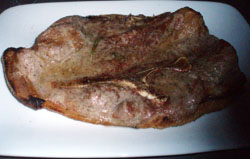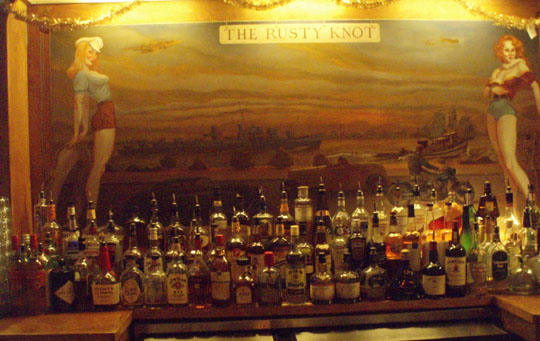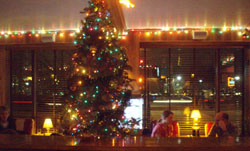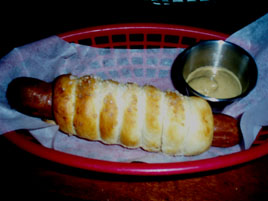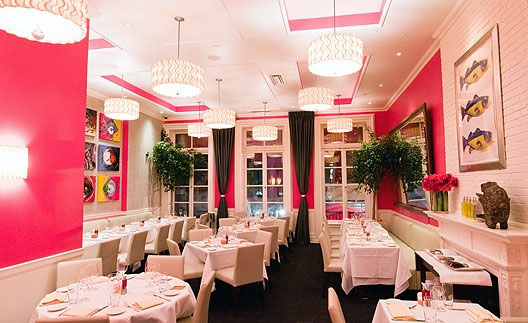
[Kreiger via Eater]
Note: As I predicted, Fishtail followed the pattern of other David Burke restaurants, and sank gradually into irrelevance. It closed in early 2016, long after Burke himself had moved on to other ventures.
*
We’re in a seafood moment, or maybe it’s just a coincidence. Over the last month, we have compelling new entries at the opposite ends of town, The John Dory in Southwest Chelsea and Fishtail on the Upper East Side. They’re stylistic opposites too: an edgy downtown vibe at one, old-money splendor at the other. Both places work more fish art into their décor than I ever believed possible.
I expect Fishtail to face a lot of skepticism among the Internet chattering class, many of whom believe the civilized world ends at 59th Street. But Fishtail in its early days is a surprisingly good restaurant. Ignore, if you must, the Park Avenue ladies and their face lifts. Focus instead on the bounty of fish, impeccably prepared.
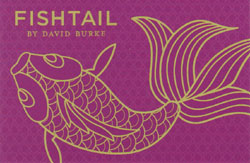 The ringmaster here is David Burke. No mere chef, the owner (says his website) is “blurring the lines between chef, artist, entrepreneur and inventor.” Most conglomerate chefs at least adopt the pretense of dressing the part, even if you know they won’t be there after the review cycle is over. Burke doesn’t even bother. He was there on a Saturday night working the room, dressed in civvies.
The ringmaster here is David Burke. No mere chef, the owner (says his website) is “blurring the lines between chef, artist, entrepreneur and inventor.” Most conglomerate chefs at least adopt the pretense of dressing the part, even if you know they won’t be there after the review cycle is over. Burke doesn’t even bother. He was there on a Saturday night working the room, dressed in civvies.
I had my doubts about Fishtail. I paid three visits to his other Upper East Side restaurant, David Burke Townhouse (formerly David Burke & Donatella). Each time, I liked it a bit less than before. Many of Burke’s clever ideas looked interesting on paper, but didn’t quite work on the plate. And he’s spread awfully thin, lending his name to dubious enterprises like the laughable Hawaiian Tropic Zone.
At Fishtail, Burke and his culinary wit are on full display, but in the dishes we tried, practically all of it worked. Go ahead and serve a Rice Krispy Crabcake or Lobster Dumplings, but they’d better be good. And they were.
The menu features raw bar standards, small plates ($11–14), soups, salads & appetizers ($11–18), simple and whole fish à la carte ($21 & up, up, up), composed plates ($29–40) and side dishes ($6.50). You can spend a bundle, but with judicious ordering can have an excellent meal for around $50–60 a head (before wine).
Even the more expensive items seem reasonably priced for this kind of restaurant (e.g., Dover Sole, $40). A couple of items on our bill were were a bit lower than the amounts shown online, which suggests the menu is being adjusted to reality. Nevertheless, this is a luxury restaurant, and the service has most of the flourishes you’d expect at such a place.
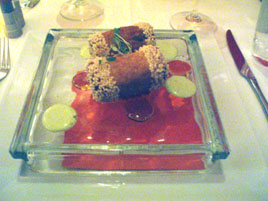

As mentioned, Rice Krispy Crab Cakes ($15; above left) and Lobster Dumplings ($12; above right) were excellent. Both dishes had examples of Burke’s wit—the clever glass serving plate used for the crab cakes, the little tiny tails poking out of the dumplings. You can’t eat humor, but I’d gladly order these dishes again.
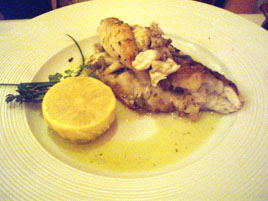
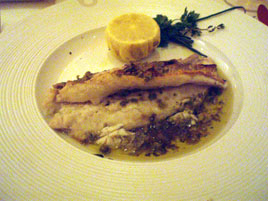
A whole Branzino ($27; above left) and a whole Red Snapper ($33; above right) were both prepared perfectly. In each case, the whole fish was presented in a skillet and then filleted at a serving station. Both were listed as portions for one, but the Snapper could easily have been for two.
There are sauces and garnishes for the whole fish, in a menu category called “Top Hats”—complement to Tails, get it? These are $7.50 apiece and ample enough to share, but I wouldn’t bother. A Gnocchi & Wild Mushroom sauce added nothing to these already excellent fish, and it was served slightly lukewarm.
Several of the whole fish are priced “by the pound,” a practice that can only lead to confusion. That Snapper, for instance, was $22/lb., but the menu stipulated it was 1½ pounds. So why not be done with it, and just put $33 on the menu? The Branzino, on the other hand, was listed at its correct price of $27.
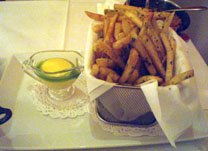
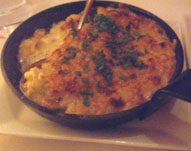

French fries ($6.50; above left) were served in a miniature frying basket with homemade mayo. The first batch was cold and soggy. After we complained, they brought up another batch moments later, which was perfect. Cauliflower Brûlée ($6.50; above center) didn’t need a do-over: it came in a sizzling hot cast-iron dish, and was terrific.
The wine service, already very good, still needs some tweaks. A server offered to send over a sommelier before we’d even seen menus. The wine list, printed in 8-point type, is practically unreadable. What could they have been thinking? After I’d squinted my way through it, I found a great Crozes Hermitage ($50; above right). It would have been harder to find a bargain among the reds. There are some compelling verticals with real age on them, but at prices well above our budget.
 The “petits-fours” (right) were little daubs of sorbet inside a candy wrapper, served on ice. It was the only time in the meal when the “chef–inventor” got too cute for his own good.
The “petits-fours” (right) were little daubs of sorbet inside a candy wrapper, served on ice. It was the only time in the meal when the “chef–inventor” got too cute for his own good.
Aside from that, service was impressive, with plenty of staff in ties and vests scurrying efficiently. There were warm baguettes at the beginning of the meal, though two people shouldn’t be asked to share one butter knife.
The restaurant is set up on two floors of a townhouse, with the bar and the kitchen downstairs, and two dining rooms up above. Food runners will get plenty of exercise shuttling food upstairs, and as noted, a couple of items came out not quite warm enough.
The space is lovely, if you don’t mind bright red. It is not quite as cramped as David Burke Townhouse, but you still get a sense that there isn’t an inch to spare. Our two-top was just six inches away from the next one.
David Burke seems to have a built-in Upper East Side fan club. His earlier restaurant is perpetually packed, and his clientele seems to have followed him over to Fishtail. If I have a concern, it’s whether Burke and executive chef Eric Hara can keep up the quality after Burke moves onto other projects.
But for a one-month-old restaurant, Fishtail is impressive. I hope it will stay that way.
Fishtail (135 E. 62nd Street between Park & Lexington Avenues, Upper East Side)
Food: ★★½
Service: ★★½
Ambiance: ★★
Overall: ★★½
 Wednesday, January 14, 2009 at 12:16PM
Wednesday, January 14, 2009 at 12:16PM 
 Fabio Trabocchi,
Fabio Trabocchi,  Fiamma,
Fiamma,  Stephen Hanson in
Stephen Hanson in  Restaurant Industry
Restaurant Industry 










